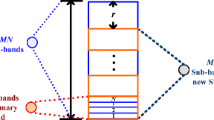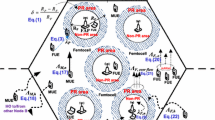Abstract
Call admission control (CAC) is important for cellular wireless networks in order to provide quality of service (QoS) requirements to users. Guard channel scheme is one of the CAC schemes. There are different computational models for analyzing the guard channel scheme which make unrealistic assumption of exponential distribution for both call holding duration and cell residence time for computational tractability. On the other hand, there are some more realistic models for guard channel schemes which capture general distributions of call holding duration and cell residence time by phase type distributions but are computationally cumbersome to implement. The state-spaces of the Markov chains for those models make the computation intractable. In this paper, we develop a tractable computational model to analyze guard channel scheme with general cell residence time and call holding duration captured by phase type distributions. We make our mathematical model computationally tractable by keeping track of the number of calls in different phases of the channel holding time instead of the phase of the channel holding time of individual calls.
Similar content being viewed by others
References
Ahmed, M. H. (2005). Call admission control in wireless networks: a comprehensive survey. IEEE Communications Surveys & Tutorials, 7(1), 49–68.
Alfa, A. S., & Li, W. (2002). A homogeneous PCS network with Markov call arrival process and phase type cell residence time. Wireless Networks, 8(6), 597–605.
Fang, Y., Chlamtac, I., & Lin, Y.-B. (1998). Channel occupancy times and handoff rate for mobile computing and PCS networks. IEEE Transactions on Computers, 47(6), 679–692.
Gaver, D. P., Jacobs, P. A., & Latouche, G. (1984). Finite birth-and-death models in randomly changing environments. Advances in Applied Probability, 16(4), 715–731.
Ghaderi, M., & Boutaba, R. (2005). Call admission control in mobile cellular networks: a comprehensive survey. International Journal on Wireless Communications and Mobile Computing, 6(1), 193–207.
Ghaderi, M., & Boutaba, R. (2006). Call admission control for voice/data integration in broadband wireless networks. IEEE Transactions on Mobile Computing, 5(3), 193–207.
Guerin, R. A. (1988). Queueing-blocking system with two arrival streams and guard channels. IEEE Transactions on Communications, 36(2), 153–163.
Haring, G., Marie, R., Puigjaner, R., & Trivedi, K. (2001). Loss formulas and their application to optimization for cellular networks. IEEE Transactions on Vehicular Technology, 50(3), 664–673.
Hong, D., & Rappaport, S. S. (1986). Traffic model and performance analysis for cellular mobile radio telephone systems with prioritized and nonprioritized handoff procedures. IEEE Transactions on Vehicular Technology, 35(3), 77–92.
Jayasuriya, A., Green, D., & Asenstorfer, J. (2001). Modelling service time distribution in cellular networks using phase-type service distributions. In IEEE international conference on communications (Vol. 2, pp. 440–444) June 2001.
Leong, C. W., Zhuang, W., Cheng, Y., & Wang, L. (2004). Call admission control for integrated on/off voice and best-effort data services in mobile cellular communications. IEEE Transactions on Communications, 52(5), 778–790.
Leong, C. W., Zhuang, W., Cheng, Y., & Wang, L. (2006). Optimal resource allocation and adaptive call admission control for voice/data integrated cellular networks. IEEE Transactions on Vehicular Technology, 55(2), 654–669.
Levine, D. A., Akyildiz, I. F., & Naghshineh, M. (1997). A resource estimation and call admission algorithm for wireless multimedia networks using the shadow cluster concept. IEEE/ACM Transactions on Networking, 5(1), 1–12.
Lin, Y.-B., Mohan, S., & Noerpel, A. (1994). Analyzing the trade-off between implementation costs and performance PCS channel assignment strategies for hand-off and initial access. IEEE Personal Communications, 1(3), 47–56.
Mišić, J., Chanson, S. T., & Lai, F. S. (1997). Event based resource estimation in admission control for wireless networks with heterogeneous traffic. ACM SIGMOBILE Mobile Computing and Communications Review, 1(4), 17–24.
Naghshineh, M., & Schwartz, M. (1996). Distributed call admission control in mobile/wireless networks. IEEE Journal on Selected Areas in Communications, 14(4), 711–717.
Orlik, P. V., & Rappaport, S. S. (1998). A model for teletraffic performance and channel holding time characterization in wireless cellular communication with general session and dwell time distributions. IEEE Journal on Selected Areas in Communications, 16(5), 788–803.
Ramaswami, V., & Lucantoni, D. M. (1985). Algorithms for the multi-server queue with phase type service. Communications in Statistics—Stochastic Models, 1(3), 393–417.
Ramjee, R., Towsley, D., & Nagarajan, R. (1997). On optimal call admission control in cellular networks. Wireless Networks, 3, 29–41.
Tekinay, S., & Jabbari, B. (1992). A measurement-based prioritization scheme for handovers in mobile cellular networks. IEEE Journal on Selected Areas in Communications, 10(8), 1343–1350.
Wilf, H. S. (1978). Combinatorial algorithms. New York: Academic Press.
Wu, S., Wong, K. Y. M., & Li, B. (2002). A dynamic call admission policy with precision QoS guarantee using stochastic control for mobile wireless networks. IEEE/ACM Transactions on Networking, 10(2), 257–271.
Author information
Authors and Affiliations
Corresponding author
Rights and permissions
About this article
Cite this article
Rahman, M.M., Alfa, A.S. Computationally efficient method for analyzing guard channel schemes. Telecommun Syst 41, 1–11 (2009). https://doi.org/10.1007/s11235-009-9146-0
Published:
Issue Date:
DOI: https://doi.org/10.1007/s11235-009-9146-0




